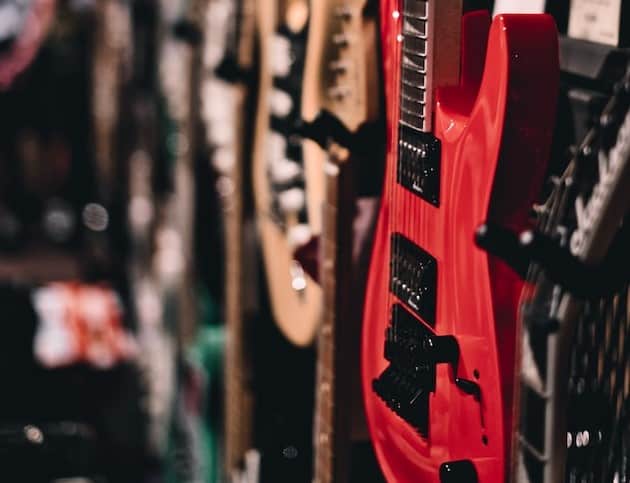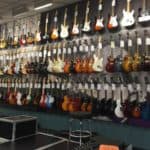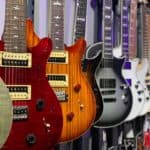Getting your first electric guitar, or the next one in your collection can be a bit overwhelming, especially if you are just taking the first steps in your musical journey.
There are many options out there, and the fear of making the wrong decision is natural for a thing like this.
Nobody was born an expert, and getting to know the things you should be looking for might take some time.
It’s always recommended to get advice from a friend or teacher that knows about guitar, but more importantly, that knows you.
However, this is not always a possibility, and because of that, I prepared this simple guide.
Here are 7 things you should look for when buying an electric guitar.
- Price
- Aesthetics
- Comfort and playability
- Build quality
- Materials, parts, and features
- Upgradeability
- Particular tone and compatibility with your gear
In this article, I will tell you all you need to know before closing the deal for your next guitar.
After leaving this page, you will know exactly how to make sure you are not coming back from the store with a lemon.
Are you ready to get started?
Let’s go!
1. Price
Having a strict budget before driving to the guitar store is fundamental to making your final decision efficiently.
This way you wouldn’t waste time trying out instruments that are way out of your league and feeling you settled for too little when you find the one that matches your wallet.
Luckily, nowadays there are great guitars at every price point, and it’s just a matter of finding which is the best fit for you.
2. Aesthetics
Many aficionados will probably argue against this item being this high on the list, however, I think it is ultimately one of the most important ones.
You shouldn’t buy a guitar that you consider ugly.
And ugly is subjective, perhaps you love bright green finishes with sparkles. Go for it.
I’ve heard somewhere that guitar stores should have mirrors for you to try on guitars and how you look with them.
I think this is a great idea.
Guitars are a part of your personality, let’s face it, and a lot of them come first through the eyes.
Use it as a first filter while browsing the incredible variety that’s out there.
Whatever stands out and resonates with you in terms of looks would be a great starting point for your quest.
3. Comfort and playability
After finding a good-looking instrument you should make sure it feels good in your hands.
And this is a very personal thing.
We all have different bodies and preferences. Some will prefer guitars with bigger bodies, others the smallest around.
This is also true for features such as fretboard radii or even fret sizes, but mostly neck shape and thickness are what could make or break a guitar for you.
Don’t worry too much about action (how high the strings are from the fretboard) since a proper setup is likely to solve that.
If you are not too experienced with the different variants available in the market, what better place to test them than at the store?
I recommend you visit in an hour that’s not too busy and look for a friendly seller that could help you with examples of the extremes.
For instance, ask to play a guitar with a thick neck, and one with a thin one. Even if these have nothing to do with what you are looking for, this will help you understand what your preferences are.
Remember playability and comfort are some of the most difficult things to improve on an instrument.
There’s nothing much to do other than get a new guitar if you get this one wrong.
So take your time and experiment for a bit.
4. Build quality
Analyzing the build quality of an instrument is important for knowing if you are paying for what you get or not.
I wouldn’t be so strict with more affordable models, however, it would be nice to compare different brands at a similar price point to figure out if any is slightly ahead of the others.
But what should we be comparing?
Well, anything with regards to finishes and how parts fit together.
Here is a brief checklist:
- Is the paint applied evenly?
- Are paint stains where they shouldn’t be?
- How tightly does the neck fit in its pocket?
- Is the fretboard glued properly?
- Do you feel sharp frets when you pass your hand along the neck?
- Are the plastic parts properly cut and sanded down?
- Are the borders of the instrument’s body ergonomically shaped?
- Is the neck warped in some way?
If there’s anything too evident you will probably pick it out at a first glance.
5. Materials, parts, and features
Materials, parts, and specific features guitars have are pretty much what defines how they sound.
You probably have a preference for it, even if you never thought about it.
Just look at what your guitar idols are playing.
Do you see any patterns?
I know types of tonewoods are hard to identify by just looking at a youtube video, but you could get the hang of what kind of guitars they are playing overall.
What brands of guitars do they usually play?
Do they use single-coil or humbucker pickups?
Do their guitars have floating bridges with tremolo bars?
Are their guitars solid body, semi-hollow, or hollow?
These are some of the categories you can think of when defining what kind of guitar would work out best for you.
Once you have a broad idea, and maybe have done a bit of research online, go to the store and try these different traits out.
Remember it’s always ok to ask for a friend’s opinion about what you should look for based on the music you intend on playing.
And if you don’t know anyone to ask for advice, feel free to join our Facebook community where we surely will help you out!
6. Upgradeability
If you are a tweaker by nature and enjoy working on your things to make them better, considering the “upgradeability” potential of the guitar you are about to buy might be of importance.
And by an upgradeable guitar, I refer mostly to an instrument that’s well constructed, that feels alright when you play it, and that is built with materials and with a construction type that works out for you.
What I mean by this is that if you get an alder body Stratocaster you won’t be able to upgrade it to a semihollow maple-poplar-maple body.
So, foundational things should be there, however, anything from tuners to the nut, to the pickups, to the bridge and electronics can be easily swapped out for better quality components.
7. Particular tone and compatibility with your rig
Finally, when shopping for a guitar I recommend you think about how it would work with the rest of your rig.
For instance, if you have a Diezel VH4 at home (a very heavy-metal amp) it might be weird if you were looking for a jazz archtop guitar.
The opposite would also be true, say if you have a Fender Deluxe Reverb back home (a very sparkly clean amp) it might not be the best match for an 8-string active-pickup metal machine of a guitar.
However, I encourage you to prove me wrong if you are crazy enough to try out these combinations.
Now, without going to the extremes as I exemplified before, try to get a guitar that matches the rest of your current gear, or that you aspire to get in the future.
Again, if you are not pretty sure about what are some good gear pairings, look at what the bands you follow are using, or ask your friends about their opinion.
How to test a guitar in the store: 12 steps
I don’t think there’s a standard way of testing a guitar as if you were a robot, however here’s a list of a few steps one could reasonably take in order to determine the quality of an instrument.
1. Look at the guitar closely for imperfections
Stop! Don’t even strum it yet!
Get that guitar close to your face and scan it for anything that looks off. Maybe if you find a ding that shouldn’t be there you could negotiate a discount with the store owner.
Hey, even if the guy is a rough negotiator, it’s better that you found out about it before taking that instrument home and regretting it.
2. Roll every pot, flick every switch
Sometimes guitar pots and switches can get scratchy, especially if they were hanging from a store wall for a while.
Even a cable could have gotten loose somehow, so it’s better to check than to regret it.
These are things very easily fixable, and the store could probably solve it for you if you end up picking this particular guitar.
3. Check for tuning issues
Tuning issues in a guitar can come from certain different places and the best way of testing it is by just tuning up the instrument and playing it for a while.
Does it keep tuning reasonably well?
Remember guitars are never perfect, but they should remain playable at least for a few songs until requiring slight adjustments.
4. Check for intonation issues
Intonation on a guitar is sometimes confused with tuning, but it’s actually a different concept.
A guitar could be perfectly in tune but still, have intonation issues.
These issues manifest in the form of particular notes or groups of notes being out of tune even when the guitar is perfectly tuned.
Dead strings can be the culprit of it, so check first for that.
Neck relief can also cause these issues.
The rule of thumb is that if something sounds off, first compare it with another guitar, and if you still have doubts ask a seller for help.
5. Play some tunes you like
Remember you are not a robot.
Rock some riffs you love and get a feel for it.
Does it make you smile?
If yes, keep going.
If not, what are you even doing with that guitar?
6. Try it with an amp as close as yours as possible
Again, context matters a lot, and it would be a shame if you tried a guitar out with a great amp at the store and fell in love with it, just to bring it home and hate it when plugged into your own rig.
If bringing your amp to the store sounds too crazy, I think taking some pedals with you might be more reasonable.
Try to test the guitar in a context as close to home as possible.
Look for the most similar amp they have available to the one you’ve got at home, and try it out with it.
7. Look for fret wear
For new guitars, you shouldn’t expect any fret wear, unless they have been in the store for a while and a lot of people had already test-driven them.
On used instruments, fret wear is more common.
It’s not terrible, you can always refret the instrument, but it will cost you some money.
This is another thing that could get you a discount if you still like the guitar over it.
8. Check for fret buzz
Fret buzz can, in most cases be fixed with a proper setup, however, it’s still something to take into consideration.
Play a low fretted note and check if anything buzzes.
9. Test the action and look for neck relief
Is the action (string height) of the guitar comfortable for you?
If it’s too high, perhaps the neck is bent slightly inwards, which can be solved with a slight adjustment of the truss rod.
Any good instrument can have its action properly set up by a good technician, however, for more affordable ones, I would make sure it comes out of the store with an action I could play with.
10. Look for neck warping issues
Woods that have not been properly stationed can shift in shape slightly even after being cut and made into a guitar.
This could cause a guitar neck to be slightly twisted or skewed towards one side when looked at horizontally from the bridge.
Avoid any guitar that presents an issue like this one since it might require a complete neck replacement.
11. Try out a few units of the same model
Every tree is unique and even two guitars made the same day back to back can end up sounding different.
When have decided on a particular model, ask for as many units they have in stock (and that they allow you to try out) and see if there’s a certain one that works out better for you.
This might sound silly, but you could be very surprised about the actual variance between them.
12. Compare with other similar-priced guitars
Finally, if you want to be absolutely thorough with your decision, when you have a winner, put it against other comparable instruments.
Perhaps go a bit higher in price if you are really confident that this is the one.
This will be the last step to eradicating any kind of doubt about your decision that you still have in your mind.
The B-string test
There’s a particular test I have heard or read about somewhere I can’t remember that stuck with me.
As a disclaimer, I don’t know really how effective it is at determining the quality of a guitar but could be something to add to the steps above.
It’s called the b-string test, and it is quite simple:
Pick a guitar, or even leave it hanging from the wall. Now pluck its b string. Immediately check if you can feel it vibrating when touching the lower strap button.
Another variant I heard was checking for the vibration by placing the palm of your hand at the tip of the headstock.
Does this really help you check how resonant the instrument is? Well, probably.
Does that matter? I think it does.
Should you consider getting a used guitar?
I’m a great advocate for used guitars.
Many beginners might not like them because of preconceptions you might bring from buying other things.
Used sneakers are probably always not as good as a pair of fresh ones.
However, this is not true for guitars.
One could argue that used instruments can even be better than newer ones because the materials have had more time to settle and humidity to escape the wood.
All these claims are disputed, but what’s true is that you could find better deals with used gear, although you wouldn’t be able to pick colors or certain other features or variants that a store would surely have in stock.
Buying a guitar online vs at the store
I really believe you should try out a guitar before buying it unless you are getting it more as a collector than a player.
It would ultimately depend on how much optimizing for the best instrument possible for your money matters to you.
When buying online you wouldn’t be able to take the steps I mentioned above for testing the instrument.
And yes, most online retailers offer you the possibility to return it, but that’s an extra hassle I don’t usually enjoy.
But well, sometimes the only way of getting a piece of gear is online, and there’s nothing wrong with it.
I would go with reputable brands, though, since they are more likely to sell instruments up to a certain quality standard.
Things to not worry about on a new guitar
When getting a new guitar there are certain things you shouldn’t stress about because are easily or cheaply solved or modified.
Here are some of them:
- String gauges
- String action
- Volume pot values or any other electronics
- Lack of a treble bleed circuit
- Low-quality nut
- Small strap buttons
- Pickguard color (for models where they are easily available at stores)
- Intonation or other setup issues
Remember a good amp or effects processor is also important
Finally, and without any intention to make you second guess your choice of getting a new guitar: Remember that a good amp or digital amp has a bigger impact on your overall tone than the guitar itself.
This is particularly true when jumping from an affordable amp to a more “professional” one.
Pedals and effects are also important.
It’s true, however, that guitars are more of a fetish for us musicians since it’s the piece of the rig that we most interact with when doing our thing.
But it’s my duty as the GearAficionado to let you know that if you want the best tone for your buck, it would be most easily achieved with an affordable guitar paired with a really good amp, rather than with an amazing guitar going into a cheap amp.
This is a fact a lot of us don’t want to accept.

Hello there, my name is Ramiro and I’ve been playing guitar for almost 20 years. I’m obsessed with everything gear-related and I thought it might be worth sharing it. From guitars, pedals, amps, and synths to studio gear and production tips, I hope you find what I post here useful, and I’ll try my best to keep it entertaining also.





